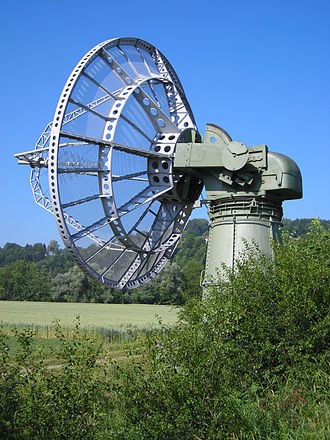Lead Observatory
|
Telescope Lead Observatory |
|
|---|---|

|
|
| Parabolic antenna of the Lead Observatory for Radio Astronomy | |
| Type | Spectrometer (radio range) |
| Location | near Gränichen , Switzerland
|
| height | 469 m. ü. M. |
| Geographic coordinates | 47 ° 20 '23.5 " N , 8 ° 6' 41.8" E |
| wavelength | 6 cm to 15 m |
| Aperture | 7 m and 5 m
|
| Installation | 1979 |
| Specialty | Radio telescope with the world's largest bandwidth from 2005 to 2015 |
The lead observatory , also RSG (Radiospektrometer Gränichen), serves to receive cosmic radio waves in Gränichen ( Switzerland ).
Geographical location
The observatory is near the hamlet of Bleien, 5 km south of the center of Gränichen in the canton of Aargau . The place is in the middle between Zurich and Bern, which are each about 50 km away. The location in the flat Wynental is relatively protected from earthly disturbances.
history
The observatory was built in 1979 by ETH Zurich under the direction of Professor Arnold Benz . It has consisted of two parabolic antennas with a diameter of 7 and 5 meters at a distance of 100 m and a laboratory building with a spectrometer and other electronics. For the first time, a fully digital, remote-controlled receiver was used. Since then, the spectrometers have been further developed over several generations. Starting with frequency-agile receivers, digital filter banks and FFT spectrometers are in use today . The frequency range was also expanded from originally 100 to 1000 MHz to the current range of total meter and decimeter waves from 20 MHz to 5 GHz. As of 2005, this frequency range was the largest bandwidth of solar radio observations worldwide. The observatory was rebuilt in 2015 to receive non-solar radio radiation of extragalactic and cosmological origin.
science
The primary objective was to observe radio emissions from solar flares . The most important contribution was the systematic cataloging of the decimetric wavelengths ( UHF ). It served to research the acceleration of high-energy electrons . The broad spectral range was also used for extrasolar measurements, for example to search for radio waves from gamma-ray bursts and to observe FRTs ( Fast Radio Burst ).
All the data since 1979 and the instrumental descriptions are stored at the University of Applied Sciences Northwestern Switzerland FHNW and are publicly accessible. The lead observatory has been part of the international network e-CALLISTO since 2008 for the 24-hour monitoring of solar activity and space weather in the radio wave range. Today the observatory is also used for cosmological measurements, for the development of new devices and for student internships.
Web links
- Gränicher window into space on aargauerzeitung.ch
Individual evidence
- ^ Committee on Radio Astronomy Frequencies, http://www.craf.eu/radio-observatories-in-europe/bleien/
- ↑ MR Perrenoud, The Computer-controlled Solar Radio Spectrometer "Ikarus", Solar Physics, 81, 197-203 (1982), http://soleil.i4ds.ch/solarradio/data/Descriptions/ikarus.pdf
- ↑ AO Benz, C. Monstein, M. Beverland, H. Meyer, B. Stuber, High Spectral Resolution Observation of Decimetric Radio Spikes Emitted by Solar Flares, Solar Physics, 260, 375–388 (2009), bibcode : 2009SoPh .. 260..375B
- ↑ M. Guedel and AO Benz, A catalog of decimetric solar flare radio emission, Astronomy and Astrophysics Supplement, 75, 243-259 (1988), http://adsabs.harvard.edu/cgi-bin/nph-data_query?bibcode = 1988A% 26AS ... 75..243G & link_type = ARTICLE & db_key = AST & high =
- ↑ H. Isliker and AO Benz, Catalog of 1-3 GHz solar flare radio emission, Astronomy and Astrophysics Supplement, 104, 145-160 (1994), http://adsabs.harvard.edu/cgi-bin/nph-data_query ? bibcode = 1994A% 26AS..104..145I & link_type = ARTICLE & db_key = AST & high =
- ↑ Bleien Solar Radio Data, http://soleil.i4ds.ch/solarradio/
- ↑ e-CALLISTO, International Network of Solar Radio Spectrometers, http://www.e-callisto.org/
- ↑ Radioteleskop Bleien (RSG), http://www.astro.ethz.ch/research/facilities/radioteleskop-bleien.html